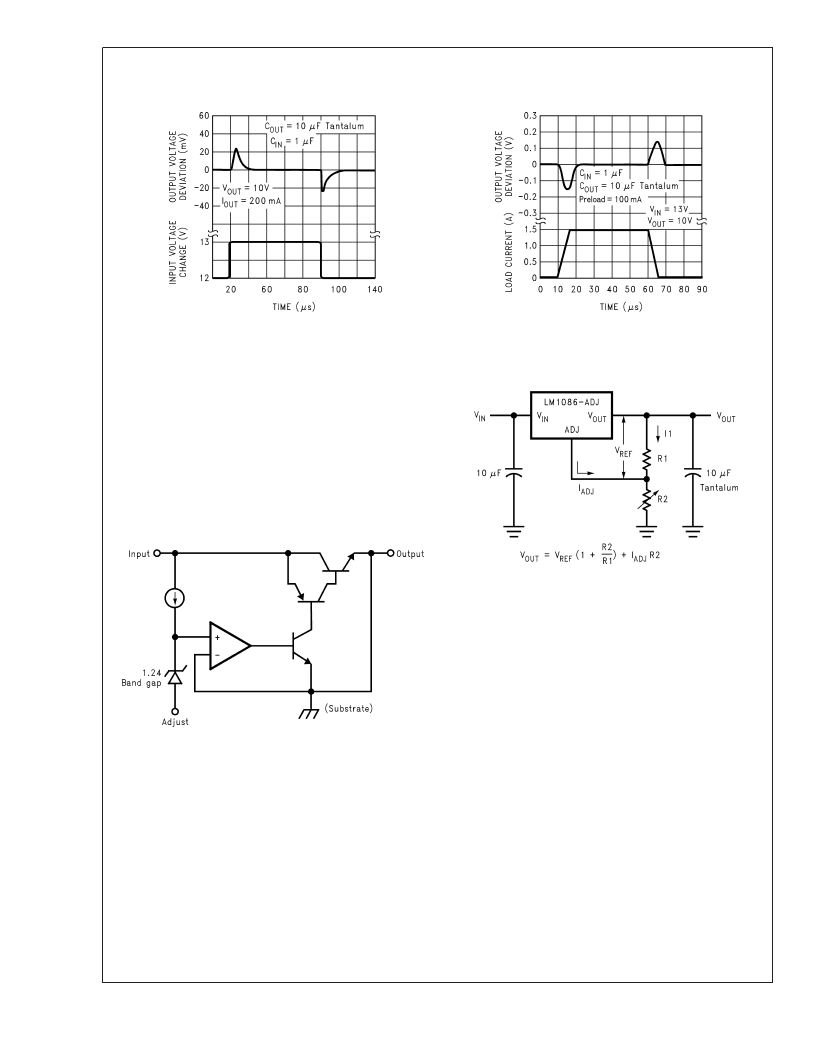- 您現(xiàn)在的位置:買賣IC網(wǎng) > PDF目錄358804 > LM1086ISX-5.0 (NATIONAL SEMICONDUCTOR CORP) 1.5A Low Dropout Positive Regulators PDF資料下載
參數(shù)資料
| 型號: | LM1086ISX-5.0 |
| 廠商: | NATIONAL SEMICONDUCTOR CORP |
| 元件分類: | 基準(zhǔn)電壓源/電流源 |
| 英文描述: | 1.5A Low Dropout Positive Regulators |
| 中文描述: | 5 V FIXED POSITIVE LDO REGULATOR, 1.5 V DROPOUT, PSSO3 |
| 封裝: | TO-263, 3 PIN |
| 文件頁數(shù): | 8/15頁 |
| 文件大小: | 822K |
| 代理商: | LM1086ISX-5.0 |

Typical Performance Characteristics
(Continued)
Line Transient Response
Load Transient Response
10094847
10094848
Application Note
GENERAL
Figure 1
shows a basic functional diagram for the LM1086-
Adj (excluding protection circuitry) . The topology is basically
that of the LM317 except for the pass transistor. Instead of a
Darlingtion NPN with its two diode voltage drop, the LM1086
uses a single NPN. This results in a lower dropout voltage.
The structure of the pass transistor is also known as a quasi
LDO. The advantage a quasi LDO over a PNP LDO is its
inherently lower quiescent current. The LM1086 is guaran-
teed to provide a minimum dropout voltage 1.5V over tem-
perature, at full load.
OUTPUT VOLTAGE
The LM1086 adjustable version develops at 1.25V reference
voltage, (V
), between the output and the adjust terminal.
As shown in figure 2, this voltage is applied across resistor
R1 to generate a constant current I1. This constant current
then flows through R2. The resulting voltage drop across R2
adds to the reference voltage to sets the desired output
voltage.
The current I
from the adjustment terminal introduces an
output error . But since it is small (120uA max), it becomes
negligible when R1 is in the 100
range.
For fixed voltage devices, R1 and R2 are integrated inside
the devices.
STABILITY CONSIDERATION
Stability consideration primarily concern the phase response
of the feedback loop. In order for stable operation, the loop
must maintain negative feedback. The LM1086 requires a
certain amount series resistance with capacitive loads. This
series resistance introduces a zero within the loop to in-
crease phase margin and thus increase stability. The equiva-
lent series resistance (ESR) of solid tantalum or aluminum
electrolytic capacitors is used to provide the appropriate zero
(approximately 500 kHz).
The Aluminum electrolytic are less expensive than tantal-
ums, but their ESR varies exponentially at cold tempera-
tures; therefore requiring close examination when choosing
the desired transient response over temperature. Tantalums
are a convenient choice because their ESR varies less than
2:1 over temperature.
The recommended load/decoupling capacitance is a 10uF
tantalum or a 50uF aluminum. These values will assure
stability for the majority of applications.
The adjustable versions allows an additional capacitor to be
used at theADJ pin to increase ripple rejection. If this is done
the output capacitor should be increased to 22uF for tantal-
ums or to 150uF for aluminum.
10094865
FIGURE 1. Basic Functional Diagram for the LM1086,
excluding Protection circuitry
10094817
FIGURE 2. Basic Adjustable Regulator
L
www.national.com
8
相關(guān)PDF資料 |
PDF描述 |
|---|---|
| LM1086CSX-5.0 | 1.5A Low Dropout Positive Regulators |
| LM1086IT-ADJ | 1 in Dia., 1 Amp Multi Deck Rotary Switch |
| LM1086IT-5.0 | 1.5A Low Dropout Positive Regulators |
| LM1086IT-3.3 | 1.5A Low Dropout Positive Regulators |
| LM1086IT-2.85 | 1.5A Low Dropout Positive Regulators |
相關(guān)代理商/技術(shù)參數(shù) |
參數(shù)描述 |
|---|---|
| LM1086ISXADJ | 制造商:Texas Instruments 功能描述: |
| LM1086ISX-ADJ | 功能描述:低壓差穩(wěn)壓器 - LDO RoHS:否 制造商:Texas Instruments 最大輸入電壓:36 V 輸出電壓:1.4 V to 20.5 V 回動電壓(最大值):307 mV 輸出電流:1 A 負(fù)載調(diào)節(jié):0.3 % 輸出端數(shù)量: 輸出類型:Fixed 最大工作溫度:+ 125 C 安裝風(fēng)格:SMD/SMT 封裝 / 箱體:VQFN-20 |
| LM1086ISX-ADJ/HAPB | 制造商:Texas Instruments 功能描述: |
| LM1086ISX-ADJ/NOPB | 功能描述:低壓差穩(wěn)壓器 - LDO 1.5A LDO POS REG RoHS:否 制造商:Texas Instruments 最大輸入電壓:36 V 輸出電壓:1.4 V to 20.5 V 回動電壓(最大值):307 mV 輸出電流:1 A 負(fù)載調(diào)節(jié):0.3 % 輸出端數(shù)量: 輸出類型:Fixed 最大工作溫度:+ 125 C 安裝風(fēng)格:SMD/SMT 封裝 / 箱體:VQFN-20 |
| LM1086IT-1.8 | 制造商:Texas Instruments 功能描述: |
發(fā)布緊急采購,3分鐘左右您將得到回復(fù)。